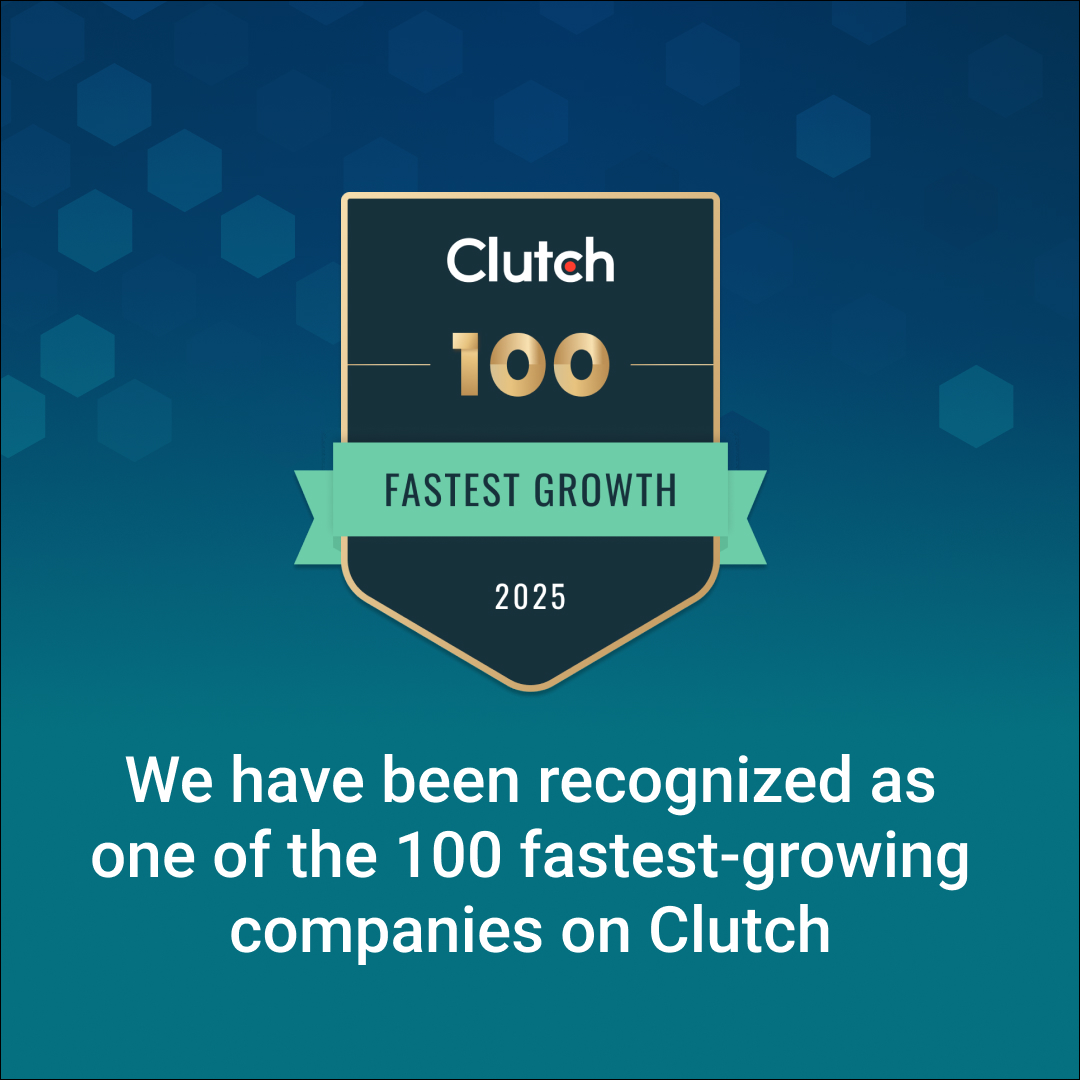Introduction
Learning and Development (L&D) is under pressure, organizations must upskill teams rapidly, customize learning paths, and keep pace with evolving roles and tech. AI is stepping in as a powerful ally, delivering personalized learning, automating content creation, and providing real-time coaching at scale. This comprehensive guide explores how AI is transforming L&D through tangible applications and strategic insights.
What is AI and Why Does It Matter in Learning & Development?
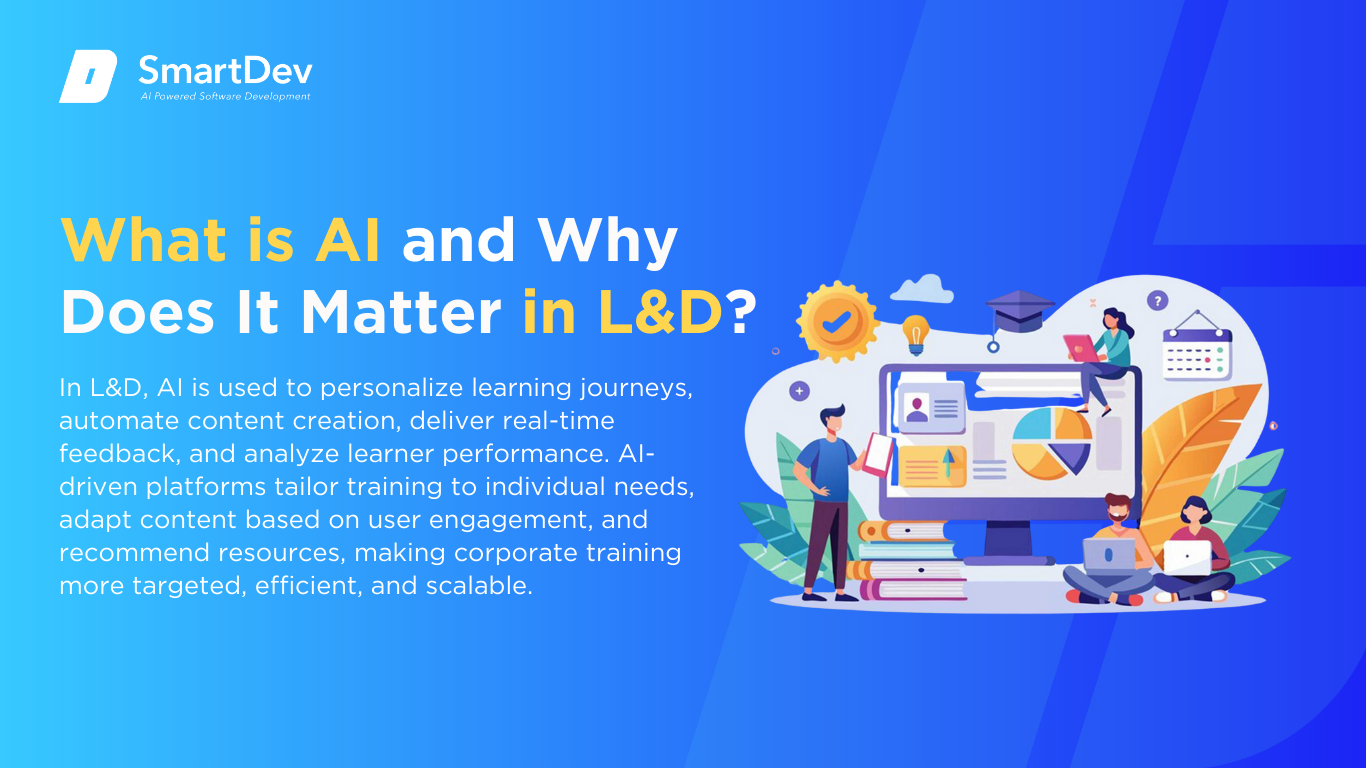
Definition of AI and Its Core Technologies
AI refers to computer systems engineered to replicate human cognitive processes such as learning, reasoning, decision-making, and pattern recognition. Its foundational technologies—machine learning (ML), natural language processing (NLP), and computer vision—allow systems to analyze massive datasets, generate insights, and continuously improve without explicit reprogramming.
In Learning and Development, AI is used to personalize learning journeys, automate content creation, deliver real-time feedback, and analyze learner performance. AI-driven platforms tailor training to individual needs, adapt content based on user engagement, and recommend resources, making corporate training more targeted, efficient, and scalable.
The Growing Role of AI in Transforming Learning & Development
AI is rapidly changing how organizations design and deliver training. Leading platforms use NLP and ML to assess learner behavior, detect knowledge gaps, and dynamically adapt training materials—enabling more engaging and effective learning experiences. For example, adaptive learning systems adjust the complexity and pace of content in real time, increasing knowledge retention.
AI also enhances strategic workforce planning. By analyzing performance data, AI tools can identify skill gaps across departments and recommend targeted upskilling or reskilling programs. Companies like IBM and PwC are already using AI to forecast future talent needs and align L&D with business priorities.
Operationally, AI is streamlining traditionally manual tasks. Tools now automate course creation, grading, and administrative workflows, freeing L&D teams to focus on strategic initiatives. AI chatbots offer 24/7 learner support, while virtual coaches guide users through training modules—scaling human-like support across large, distributed workforces.
Key Statistics and Trends in AI Adoption in Learning & Development
Professional development tools are critical for boosting employee engagement, even as overall engagement rates decline. According to the Litmos Report, 62% of employees value learning opportunities for career growth, highlighting their importance in the workplace. Furthermore, Devlin Peck notes that 92% of employees report that effective, well-planned training enhances their engagement, leading to improved job performance, satisfaction, and retention.
AI is gaining traction for its ability to personalize training, with employees showing enthusiasm for its potential. The Litmos Report reveals that 58% of employees already using AI in their roles are excited about its capacity to deliver tailored learning experiences. This personalization enables organizations to address individual learning needs at scale, fostering a more engaged and motivated workforce.
Career progression drives employees’ commitment to learning, with AI playing a pivotal role in aligning training with future goals. The Litmos Report finds that 33% of employees prioritize professional development for career advancement. By leveraging AI, as supported by Grand View Research, companies can create adaptive, goal-oriented training programs that support long-term professional growth and organizational success.
Business Benefits of AI in Learning and Development
AI delivers measurable value by addressing core inefficiencies in Learning and Development, such as generic training content, slow content creation cycles, and lack of visibility into skill readiness. Below are five business-critical benefits that AI brings to modern L&D functions:
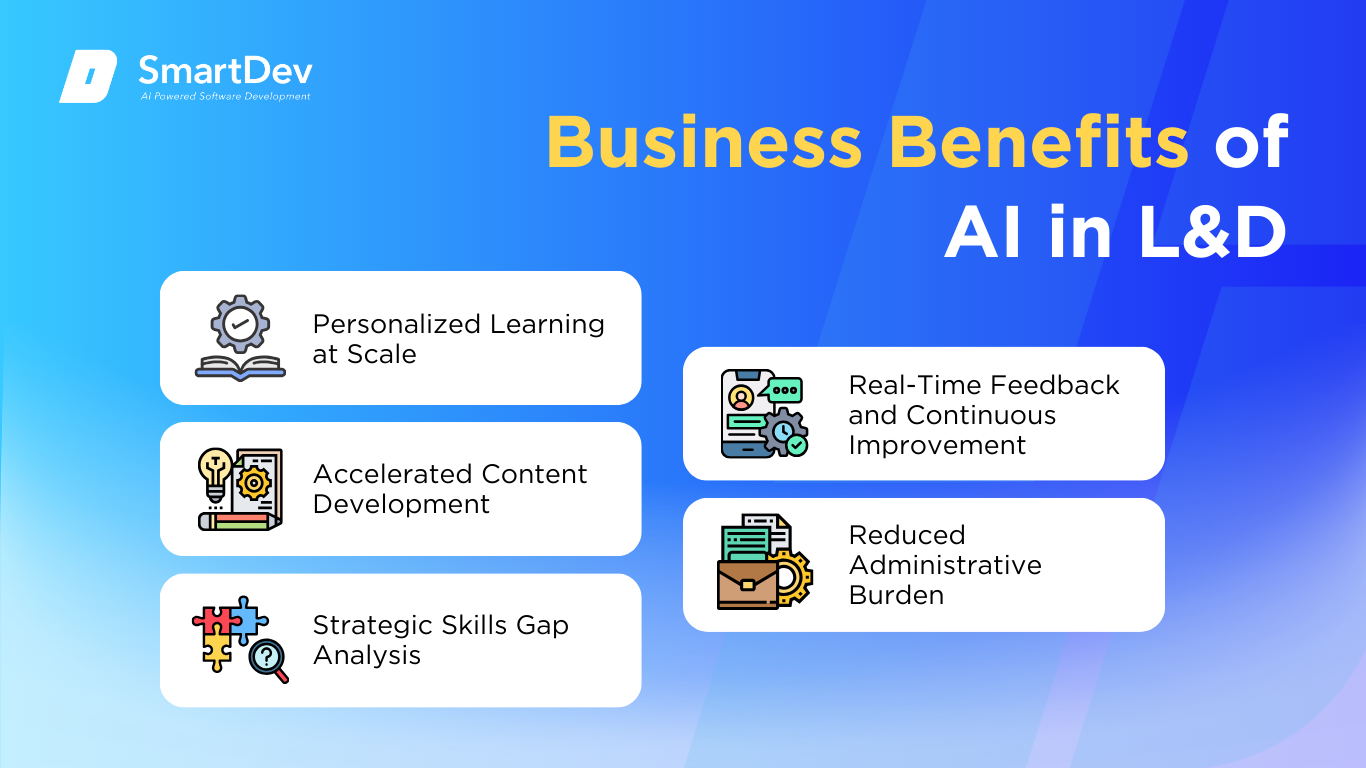
1. Personalized Learning at Scale
AI enables dynamic content personalization by analyzing learner profiles, behaviors, and performance data. This allows organizations to deliver training that aligns with each individual’s current skill level, learning style, and role-specific needs.
By replacing one-size-fits-all modules with adaptive learning paths, engagement and retention increase significantly. Personalized learning also reduces time spent on irrelevant material, improving efficiency across the workforce.
2. Accelerated Content Development
AI tools streamline content creation by automating the generation of course materials, assessments, and training documentation. This drastically reduces production timelines and allows L&D teams to respond rapidly to evolving learning requirements.
As a result, organizations can scale learning initiatives more easily and maintain up-to-date training resources. This speed and flexibility help close knowledge gaps faster and improve time-to-competency for new and existing employees.
3. Strategic Skills Gap Analysis
AI systems can assess current workforce capabilities and compare them against future role requirements or market demands. These insights support proactive planning and ensure that learning programs are directly tied to organizational growth goals.
By identifying emerging skills gaps early, companies can allocate resources more effectively and prioritize high-impact development areas. This improves workforce readiness and supports long-term talent strategy execution.
4. Real-Time Feedback and Continuous Improvement
AI provides immediate feedback to learners through automated assessments and performance tracking. This supports a more responsive learning environment where employees can adjust their progress based on timely insights.
From an operational standpoint, AI-generated analytics allow L&D leaders to monitor program effectiveness and iterate content quickly. This continuous feedback loop enhances both individual learning outcomes and overall training quality.
5. Reduced Administrative Burden
AI automates routine L&D tasks such as enrollment, progress tracking, certification management, and reporting. These automations free up time for learning teams to focus on strategic planning and learner engagement.
With AI handling repetitive operations, training departments can operate at greater scale without additional headcount. This contributes to cost efficiency and allows for better alignment with business objectives.
Challenges Facing AI Adoption in Learning and Development
While AI offers significant advantages, organizations face several real-world barriers to successful implementation in L&D. These challenges arise from structural limitations, data constraints, and the complexities of integrating AI into existing learning ecosystems.
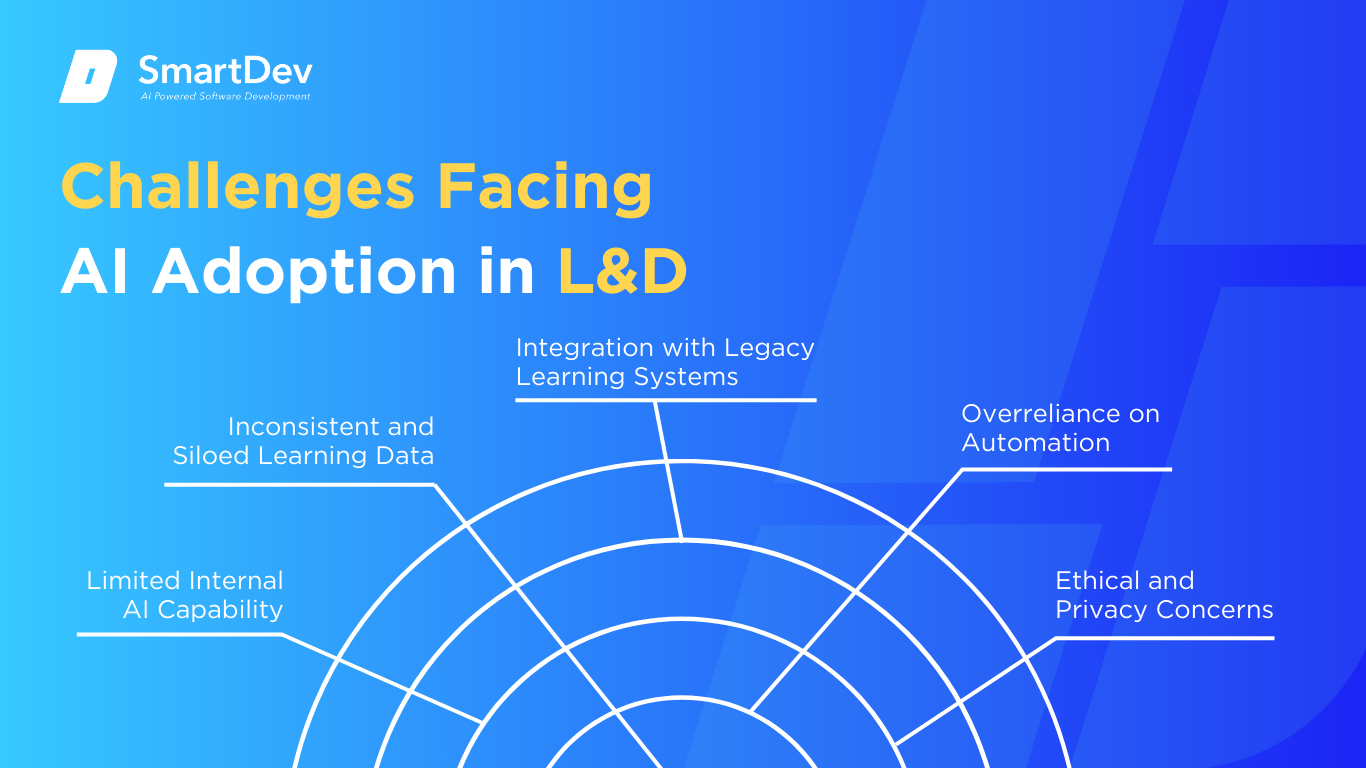
1. Inconsistent and Siloed Learning Data
AI requires unified, high-quality data to function effectively, but many L&D systems operate with fragmented datasets spread across LMS platforms, HR tools, and informal training records. Inconsistent data formats and incomplete learner profiles compromise the accuracy of AI recommendations and analytics.
Effective AI integration demands centralized data architecture and ongoing data governance. Without standardized and connected datasets, AI cannot deliver personalized insights at scale, limiting its overall impact on training outcomes.
2. Limited Internal AI Capability
L&D teams often lack the technical expertise to implement or manage AI tools effectively. Many professionals in this space come from instructional or HR backgrounds and may not be equipped to assess algorithms, interpret AI outputs, or ensure ethical usage.
This skills gap forces organizations to rely heavily on external vendors, reducing their control over customization and data ownership. It also slows innovation, as internal teams struggle to align AI tools with broader learning strategies.
3. Ethical and Privacy Concerns
Using AI in training involves collecting sensitive data about employee behaviors, performance, and development areas. Improper use of this data can raise serious concerns about surveillance, bias, and fairness in promotion or development decisions.
To address these risks, organizations must implement clear policies around transparency, consent, and data usage. However, few L&D teams currently have robust ethical frameworks in place to govern AI deployment, exposing them to potential trust issues and compliance failures.
4. Integration with Legacy Learning Systems
Many companies rely on outdated or rigid LMS platforms that were not built to support real-time AI functionality. Integrating modern AI tools into these systems can be technically complex and resource-intensive, often requiring middleware or complete platform overhauls.
These integration hurdles increase deployment costs and delay time-to-value. For organizations with limited IT support, this becomes a major roadblock to adopting AI-driven learning at scale.
5. Overreliance on Automation
While AI can enhance efficiency, overdependence on automated systems risks reducing human oversight in learning design and learner support. AI-generated content may lack the nuance and contextual sensitivity required for sensitive topics like leadership, DEI, or compliance training.
Organizations must maintain a balance between automation and human expertise to preserve content quality and learner trust. Without this balance, AI can inadvertently undermine the strategic goals of corporate learning programs.
Specific Applications of AI in Learning and Development
From personalized learning to predictive skills mapping, AI is reshaping how organizations train, upskill, and retain talent. These technologies empower HR leaders and L&D professionals to deliver more targeted, scalable, and impactful training experiences aligned with business objectives:
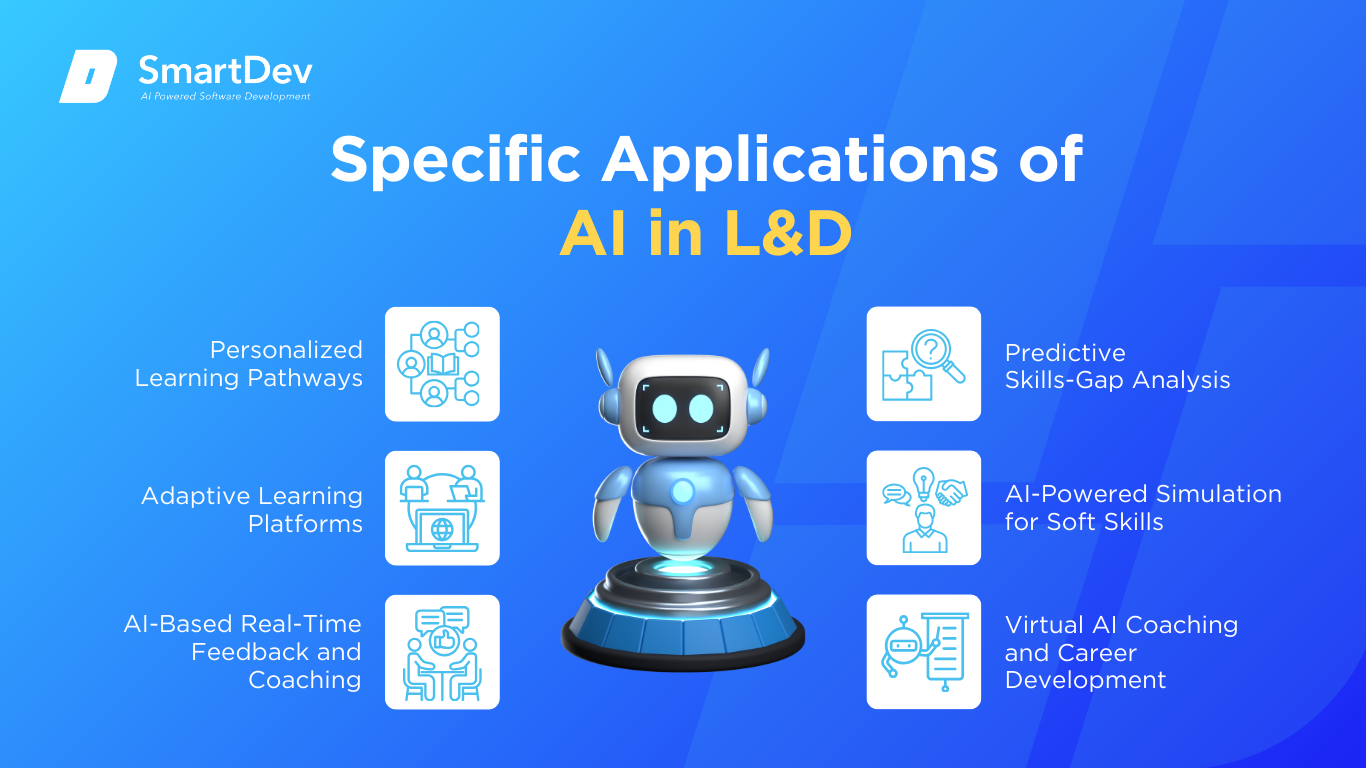
1. Personalized Learning Pathways
AI-powered personalized learning is redefining how training content is delivered to employees across industries. These systems use algorithms to dynamically tailor learning journeys based on each individual’s role, skills, learning style, and performance data. The technology solves a fundamental L&D problem: generic, one-size-fits-all training that fails to engage or deliver results.
At the core of this solution are machine learning and recommendation algorithms that analyze learner profiles, assessment scores, past behaviors, and business objectives. These insights are used to serve up the most relevant content modules, adjust difficulty levels, and sequence training steps in real-time. Integrated with learning management systems (LMS), this adaptive approach increases engagement, accelerates skill acquisition, and helps organizations scale training without sacrificing relevance.
A compelling example comes from MikMak, a digital commerce analytics company, which implemented WorkRamp’s AI-enabled learning platform. The system customizes training paths based on internal role requirements—automating the curation of modules in areas like interpersonal communication and DEI sensitivity. This personalized approach has improved learner engagement and ensured measurable competency development across departments.
2. Adaptive Learning Platforms
Adaptive learning powered by AI enables real-time customization of training materials based on user behavior and performance. These systems solve the challenge of disengaged learners by dynamically adjusting the difficulty, pace, and content sequence to match each individual’s progress. By providing a tailored learning journey, they improve knowledge retention and reduce dropout rates.
The technology behind adaptive learning platforms involves continuous assessment models and reinforcement learning algorithms. These models monitor learner inputs—such as quiz results, time on task, and response patterns—to determine mastery and adjust future content delivery accordingly. Integrated with enterprise LMS platforms, these systems deliver personalized modules that align with both learner capability and organizational skill needs.
In the education sector and corporate training environments, adaptive learning has proven highly effective. A review of 37 independent studies found that 86% reported significant improvements in learning outcomes, with users progressing faster and demonstrating stronger retention. This validates the approach as a powerful tool for increasing ROI in workforce development programs.
3. AI-Based Real-Time Feedback and Coaching
AI-enabled real-time feedback tools provide instant, actionable coaching during presentations, training simulations, or skill assessments. These systems address a major bottleneck in L&D—limited access to personalized feedback from human coaches—by delivering consistent and scalable performance evaluations. This immediacy helps learners correct mistakes faster and internalize best practices more effectively.
Natural language processing (NLP) and speech analytics are commonly used to assess parameters like tone, word choice, clarity, and pacing in spoken communication. AI systems then generate coaching prompts or scorecards, often embedded directly into video-based training or virtual workshops. These tools not only support self-guided learning but also supply managers with valuable coaching data.
One example involves AI-powered tools that analyze sales or customer service calls, delivering real-time feedback on speech clarity and empathy. This improves communication skills while enabling data-driven coaching. Managers can use the analytics dashboard to focus on coaching high-impact behaviors, improving team performance with less time investment.
4. Predictive Skills-Gap Analysis
AI-driven skills-gap analysis tools help organizations proactively identify current and future training needs. These platforms address a critical L&D challenge: aligning workforce capabilities with evolving business demands. By predicting where skill shortages will arise, organizations can invest strategically in training that supports growth and innovation.
These tools integrate with HR systems, performance data, and industry benchmarks to map employees’ current skills against role expectations or business goals. Machine learning models detect patterns in job transitions, performance reviews, and promotion paths to flag potential upskilling opportunities. Results are visualized through dashboards that help L&D teams prioritize development initiatives.
At companies like Johnson & Johnson and Bank of America, AI tools are already used to assess worker skills and recommend personalized training simulations. These predictive systems support internal mobility and reduce dependency on external hiring. Outcomes include better workforce planning and reduced talent attrition.
5. AI-Powered Simulation for Soft Skills
AI simulations offer immersive, scenario-based training environments where employees can safely practice high-stakes interpersonal interactions. These simulations solve the difficulty of training soft skills—like negotiation, leadership, and conflict resolution—by providing experiential learning at scale. Learners gain confidence and competence through repeated, feedback-rich practice.
These platforms leverage conversational AI, natural language generation, and emotional sentiment analysis to create responsive virtual characters. Users engage in branching dialogue scenarios that evolve based on their choices, mirroring real-world complexity. Performance is analyzed in real-time, offering insights into communication style, empathy, and decision-making.
Virti, an AI simulation provider, delivers virtual role-play training for healthcare, retail, and customer service professionals. The platform simulates real-life conversations and provides immediate feedback on tone, phrasing, and engagement. Clients like Amazon and the NHS report significant improvements in employee preparedness and communication efficiency.
6. Virtual AI Coaching and Career Development
AI coaching platforms provide continuous, on-demand career guidance and professional development to employees. These tools solve the problem of unequal access to mentorship and coaching, making developmental support available to employees at all levels. This democratization of coaching helps organizations retain talent and build leadership pipelines.
Virtual coaching platforms combine behavioral science, NLP, and predictive analytics to simulate human-like interactions. Employees receive personalized feedback, practice difficult conversations, set goals, and access career development plans. These systems often integrate with Slack, Microsoft Teams, or mobile apps to provide coaching in the flow of work.
BetterUp Grow, launched in 2025, exemplifies this model. The AI coach simulates workplace conversations, tracks personal development goals, and delivers behavioral insights tailored to each user. Within months of deployment, 95% of users reported satisfaction and 16% saw increased workplace confidence, highlighting its practical impact.
Need Expert Help Turning Ideas Into Scalable Products?
Partner with SmartDev to accelerate your software development journey — from MVPs to enterprise systems.
Book a free consultation with our tech experts today.
Let’s Build TogetherExamples of AI in Learning and Development
AI’s transformative potential in learning and development becomes most tangible through practical, real-world applications. The following case studies highlight how leading organizations are integrating AI into L&D strategies to drive measurable outcomes in upskilling, engagement, and performance growth.
Real-World Case Studies
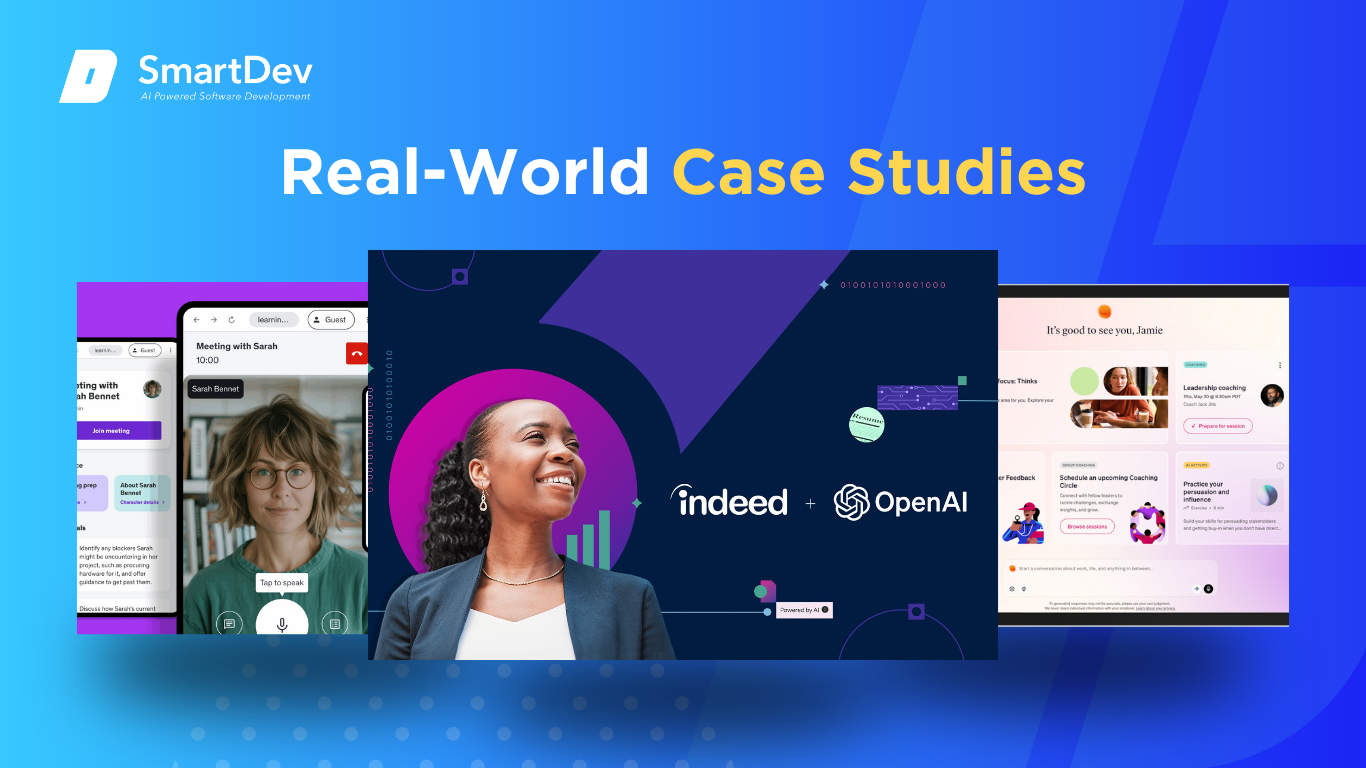
1. Indeed: AI for Workforce Upskilling at Scale
Indeed faced a widespread challenge across its global workforce—rapid AI adoption was causing uncertainty and anxiety among employees. Teams needed upskilling not only in technical AI knowledge but also in how to integrate it meaningfully into daily work. The company required a scalable solution to democratize AI literacy and boost employee confidence without overwhelming L&D teams.
To address this, Indeed rolled out an AI training initiative combining foundational e-learning, interactive tool demos, and guided practice with generative AI systems. Custom internal platforms tracked progress and encouraged experimentation while offering on-demand AI coaching. Developers now generate 33% of their code using AI, up from just 7%, reflecting massive productivity improvements and widespread AI fluency.
The impact is significant: employees reported higher satisfaction and less resistance toward AI adoption. The L&D team reduced ramp-up time for new technologies by 40%, and the initiative has become a template for cross-functional AI training at enterprise scale. It positions Indeed as a frontrunner in responsible and inclusive AI integration.
2. Udemy: Immersive Soft Skills Training with AI Role Play
Udemy observed a growing demand from business clients for more immersive soft skills training—particularly in communication, leadership, and emotional intelligence. Traditional content-based modules weren’t engaging enough and failed to offer real-world application. The company needed a solution to simulate authentic workplace interactions in a scalable, repeatable way.
In response, Udemy launched an AI-powered Role Play platform, allowing users to engage in interactive conversations with virtual characters that mirror real business scenarios. Using natural language processing and branching dialogue trees, the tool offers real-time feedback on tone, phrasing, and negotiation strategies. Learners can replay simulations, assess their performance, and receive personalized improvement suggestions.
Since its launch, the platform has seen rapid adoption across corporate clients and professionals preparing for leadership roles. Completion rates on soft skills courses have increased by over 30%, while learner feedback highlights stronger confidence in handling real-world workplace situations. This innovation has elevated Udemy’s B2B value proposition in the training marketplace.
3. BetterUp: AI-Enhanced Career Coaching for Personal Growth
BetterUp recognized that many professionals lacked access to consistent career coaching and personal development support, especially outside of executive ranks. With hybrid work on the rise, demand was growing for scalable coaching experiences that could guide employees in real-time, across locations and time zones. The company needed an AI-enabled solution to deliver personalized development at scale.
They developed BetterUp Grow, a virtual AI coach designed to simulate workplace conversations, help users set goals, and provide behavioral feedback aligned with leadership and communication frameworks. The platform integrates with Slack and mobile apps, enabling coaching within the flow of work. Human coaches complement the experience with deeper interventions when needed, creating a high-touch, AI-assisted ecosystem.
The results are impressive: 95% of users report satisfaction, and 16% experienced an increase in workplace confidence after 90 days. The system also helps HR teams track development patterns and target skill-building interventions. BetterUp Grow represents a major step toward democratizing professional growth in enterprise L&D.
Innovative AI Solutions
AI-Driven Innovations Transforming Learning and Development
Emerging Technologies in AI for Learning and Development

Generative AI is revolutionizing learning and development by enabling rapid creation of training materials, assessments, and microlearning content. L&D teams can now use these tools to produce onboarding modules, compliance quizzes, and leadership simulations at scale. This shift allows organizations to keep pace with ever-evolving skill demands, particularly in fast-moving sectors like tech, healthcare, and finance.
Computer vision is increasingly being integrated into training for frontline and technical roles. From analyzing real-time interactions in customer service to guiding hands-on repair simulations in manufacturing, AI-powered video analytics are elevating experiential learning. The result is more immersive, measurable, and effective upskilling that mirrors real-world environments.
AI-powered chatbots and NLP tools are transforming knowledge delivery across the enterprise. AI assistants help employees locate relevant documentation, answer HR or compliance queries, and even guide them through complex software processes. These tools make learning “in the flow of work” possible, reducing context-switching and dramatically improving knowledge retention and productivity.
AI’s Role in Sustainability Efforts
AI is supporting more sustainable learning operations by personalizing development pathways, reducing redundant training, and minimizing paper-based content. Adaptive learning algorithms ensure employees engage only with the material they need—optimizing learning hours and reducing training waste. This smarter allocation not only conserves resources but also lessens the carbon footprint of large-scale training rollouts.
Companies now use AI to track and optimize learning’s environmental impact—like energy use in virtual training environments or travel saved through remote learning solutions. Tools such as Watershed and Gensuite are enabling L&D leaders to model greener training programs, while AI insights help align learning strategy with ESG targets. For forward-thinking enterprises, this adds a strategic layer to L&D’s contribution to long-term sustainability goals.
How to Implement AI in Learning and Development
Step-by-step guide for adopting AI in learning and development: readiness, data, tools, piloting, and training.
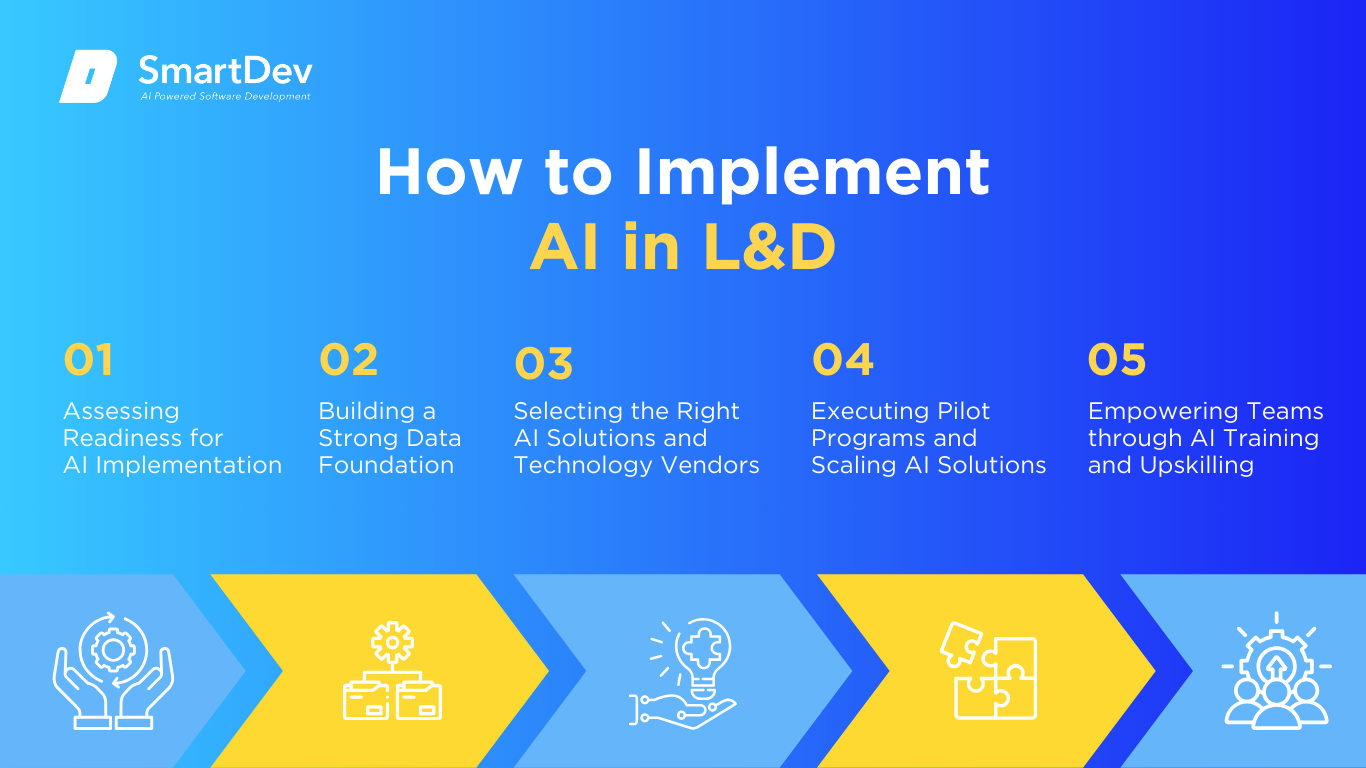
Step 1: Assessing Readiness for AI Adoption
Before integrating AI, L&D leaders must identify where AI can unlock the greatest value. Common areas include onboarding, compliance training, leadership development, and skills gap analysis. If your teams are spending excessive time creating redundant training content, struggling with learner engagement, or failing to keep pace with rapid reskilling demands, these are signs AI can drive meaningful impact.
Assessing infrastructure maturity is equally critical. Do your current LMS or LXP platforms support data-driven insights and content interoperability? Is your organization culturally ready to trust and act on machine-generated learning paths? Addressing these foundational questions ensures AI is introduced strategically, as a targeted solution to persistent challenges.
Step 2: Building a Strong Data Foundation
AI runs on data, and in learning and development, that data must be rich, reliable, and learner-centric. To maximize AI’s potential, organizations need a centralized data architecture that pulls from multiple touchpoints like LMS records, performance management systems, engagement analytics, and feedback platforms. This creates a holistic view of learner behavior, content effectiveness, and outcomes.
Clean, labeled, and standardized data is essential. Without consistent tagging, AI tools can’t personalize content effectively or track training impact. Companies like IBM and Accenture have invested heavily in data frameworks that align training content with job competencies, enabling their AI engines to deliver relevant, measurable learning journeys that scale.
Step 3: Choosing the Right Tools and Vendors
Selecting the right AI tools for L&D means balancing innovation with real-world applicability. Look for platforms that offer adaptive learning paths, generative content creation, AI-driven skills mapping, and real-time learner support. These tools should not only integrate with your existing LMS or HR tech stack, but also align with your learning objectives and governance policies.
Vendors with proven L&D domain expertise are especially valuable. Whether it’s a platform specializing in personalized leadership development or a startup offering AI-driven microlearning modules, the key is to partner with providers who understand both AI and adult learning principles.
Step 4: Pilot Testing and Scaling Up
Rather than rolling out AI across your entire L&D ecosystem, begin with focused pilot programs. This could involve using AI to automate the creation of onboarding content or personalize learning for one department. These pilots act as safe sandboxes to test usability, content accuracy, learner response, and data integration—without disrupting broader learning strategies.
Once pilot results validate AI’s effectiveness, through increased completion rates, reduced time-to-proficiency, or better engagement, you can scale incrementally. Expand use cases across teams, functions, and content types. A phased rollout not only reduces technical and cultural risk, but also helps your teams adjust processes and build confidence along the way.
Step 5: Training Teams for Successful Implementation
The best AI-powered learning programs still require capable humans behind them. Training isn’t just about teaching L&D professionals to use new tools; it’s about building fluency in AI concepts like bias detection, prompt engineering, and result validation. Instructional designers, content creators, and trainers all need to understand how AI influences learning outcomes and where human judgment remains essential.
Cross-functional collaboration is also vital. Bring together HR leaders, data scientists, IT, and L&D specialists to co-develop AI strategies. When teams work together to shape use cases, test outcomes, and iterate on design, adoption becomes smoother. Companies that frame AI as a collaborative assistant, are seeing higher engagement and long-term success in transforming how their employees learn and grow.
Measuring the ROI of AI in Learning and Development
Key Metrics to Track Success
Evaluating the return on investment for AI in learning and development involves tracking a blend of performance, engagement, and cost-efficiency indicators. One of the most significant metrics is productivity uplift, especially how quickly employees can upskill or onboard using AI-powered, personalized learning paths. For example, adaptive learning systems that reduce time-to-competency by 30% directly translate into faster role effectiveness and higher organizational agility.
Cost savings is another clear ROI lever. AI eliminates repetitive content creation, lowers the need for instructor-led training, and automates administrative tasks like scheduling, assessments, and reporting. Companies also monitor training completion rates, engagement scores, and post-training performance improvement. When learners receive targeted content that aligns with their roles and skill levels, dropout rates decrease and retention improves.
Case Studies Demonstrating ROI
Forward-thinking companies are already realizing significant ROI from AI-enhanced learning strategies. Take WorkRamp, which used AI to personalize learning experiences for a growing sales team. Within weeks, they reported an engagement rate approaching 100%, coupled with a measurable increase in early deal values and shorter time-to-first-sale—direct outcomes tied to adaptive, relevant training experiences.
Another compelling example comes from BetterUp Grow, an AI-powered coaching platform adopted by several Fortune 500s. The platform uses behavioral analytics and NLP to deliver personalized coaching interventions. As a result, users reported a 16% increase in confidence at work and a 12% improvement in productivity.
Common Pitfalls and How to Avoid Them
Despite AI’s benefits, there are common traps that can undermine ROI. One major issue is data fragmentation. Many firms have siloed or inconsistent data, leading to inaccurate predictions or model failures. To avoid this, investment managers must centralize data, enforce quality standards, and adopt tools that ensure consistent data labeling and interpretation across systems.
Another risk is overlooking the importance of human oversight. While AI can flag anomalies or generate investment suggestions, it lacks the nuance and market context that experienced analysts bring. Firms that over-automate or ignore regulatory guidelines may face compliance issues or make poor investment decisions.
Training is also often underemphasized, staff need to understand how AI works, where its limits lie, and how to use its insights effectively. Mitigating these pitfalls requires a balanced strategy: strong data governance, ongoing education, and a culture that blends technological efficiency with human judgment.
Future Trends of AI in Learning and Development

Predictions for the Next Decade
In the next decade, AI will become the engine driving a seismic shift in how organizations approach learning. One of the most transformative developments will be the proliferation of intelligent learning agents, AI systems capable of monitoring skill gaps in real time, recommending tailored learning paths, and adjusting training content on the fly based on performance and feedback.
We’ll also see the convergence of generative AI and immersive technologies like AR/VR, leading to hyper-realistic training simulations that adapt in real time. NLP will power AI coaches that understand learner sentiment and adjust tone, content pacing, or delivery mode for maximum engagement and retention.
How Businesses Can Stay Ahead of the Curve
To maintain a competitive edge, businesses must treat AI not as a plug-and-play feature, but as a foundational strategy in their talent development roadmap. That begins with investing in robust data ecosystems that track learning outcomes, skills progression, and business performance in unison. Organizations should also explore emerging technologies like conversational AI, agentic learning systems, and synthetic scenario generators to keep their L&D offerings future-ready.
Forward-looking organizations will build cross-functional teams, blending HR, L&D, IT, and business unit leaders, to champion AI initiatives. By experimenting early, measuring impact rigorously, and scaling strategically, these companies can ensure their learning strategies not only evolve with the times but help define them.
Conclusion
Key Takeaways
AI is fundamentally transforming learning and development, from automating content creation and enabling adaptive learning, to delivering hyper-personalized training and real-time coaching. With tools like generative AI, computer vision, and NLP, businesses can reduce onboarding times, close skill gaps faster, and deliver training that actually drives behavioral and business change.
Importantly, AI is also making learning more sustainable and strategic. By reducing redundant training, optimizing delivery, and aligning with ESG goals, it’s reshaping L&D into a more efficient, measurable, and future-oriented function. Real-world success stories from companies like WorkRamp, BetterUp, and PwC show that AI isn’t theoretical; it’s already producing real ROI in engagement, performance, and time-to-competency.
Moving Forward: A Strategic Approach to AI in Learning and Development
AI is no longer an L&D luxury; it’s a strategic imperative. To unlock its full potential, organizations must prioritize clean data, seamless platform integration, and workforce upskilling. By embedding AI across the learning lifecycle and fostering a collaborative, innovation-driven culture, businesses can future-proof their talent strategies.
At SmartDev, we build intelligent learning ecosystems, from AI-generated onboarding modules to real-time coaching platforms and skills-based development paths. Whether you’re automating training creation, personalizing development, or aligning learning with business performance, we’re here to help you lead the next era of intelligent learning.
Connect with us today to explore how we can help you implement AI in learning and development—securely, strategically, and successfully. Let’s build a smarter, more capable workforce for tomorrow.
—
References:
- Harnessing Employee Insights for Smarter LMS Experiences | Litmos
- Employee Training Statistics | Devlin Peck
- AI Training Dataset Market | Grand View Research
- Indeed’s Strategy to Train Employees on AI and Boost Productivity | Business Insider
- Udemy Launches AI-Powered Role-Play to Transform Soft Skills Training | Times of India
- AI Career Coach: Accessible Coaching for Professional Development | Business Insider
- Embracing Differences: Inside MikMak’s Inclusive Work Culture | MikMak
- AI Adoption by Bank of America’s Global Workforce Improves Productivity | Bank of America Newsroom
- Corporate Training: Using AI in Learning and Development | Virti


